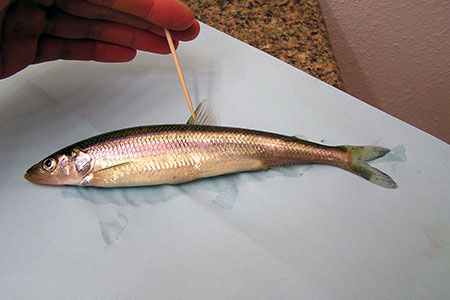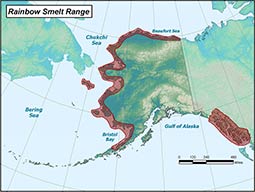Rainbow Smelt
(Osmerus mordax)
Printer Friendly
Did You Know?
Prominent teeth on the tongue of the rainbow smelt distinguish it from other species of smelt
General Description
The rainbow smelt is a small fish up to 8 inches in total length. Rainbow smelts are distinguished from other Alaska smelts by prominent teeth on the tongue and a small adipose fin. The large terminal mouth is equipped with well-developed canine-like teeth and a slightly protruding jaw.
Rainbow smelt are generally olive green dorsally and silvery white in color in salt water. The sides of the rainbow smelt are often purple, blue, or pink iridescence with colorless fins. The top of the rainbow smelt’s head, chin, and upper part of the body are speckled with black.
Life History
Growth and Reproduction
Rainbow smelt are anadromous which means it spends part of its life in the ocean and part of its life in fresh water. Rainbow smelt spawn in freshwater streams. As the spawning season approaches, rainbow smelt gather in large schools off the mouths of their spawning streams and rivers. Although rainbow smelt apparently returns to the river system in which it hatched, the return to spawning streams is often not precise.
Rainbow smelt spawning rivers are typically slow moving waterways since rainbow smelt are weak swimmers that cannot travel through long stretches of high water velocity. Spawning sites are in the lower elevations of the river or stream, although some rainbow smelt even spawn in brackish water behind barrier beaches or in the tidal zone of estuaries. Eggs are "broadcast" over sandy gravel bottoms, once fertilized a sticky substance allows them to attach to sand particles. Their adhesive eggs, about 60,000 per female, attach to sand or pebbles. The eggs hatch in freshwater in 10 to 30 days, depending on the water temperature. After emerging from the eggs, young rainbow smelt migrate downstream to salt water to grow to maturity in the sea. After two to six years at sea, they return as adults to spawn. After spawning, the majority of rainbow smelt die.
Feeding Ecology
River currents carry newly hatched young to the sea where they feed mainly on copepods and cladocerans, in addition to rotifers, eggs, and algae. Adult rainbow smelt feed on decapods and mysid shrimps, copepods, amphipods, crabs, squid, worms, and a variety of small fish and shellfish.
Migration
Since stream water temperature can affect the timing of the spawning migration, the numbers of spawning rainbow smelt returning to a particular stream can vary greatly from year to year depending on stream water conditions and overall ocean survival. The main spawning migration can occur as early as April in Southeastern Alaska. In Southcentral, Western, and on the North Slope of Alaska, spawning generally begins in May or later. Some streams can have two separate but overlapping migrations.
Range and Habitat
In Alaska, rainbow smelt inhabit waters along the entire coast but are less common in the Gulf of Alaska as other species of smelt. Rainbow smelt occur in Bristol Bay and north to Saint Lawrence Island. Rainbow smelt also occur off the mouth of the Colville River and east to Cape Bathurst, Northwest Territories, Canada.
Status, Trends, and Threats
Status
Population discreteness for rainbow smelt within and among river systems in Alaska is unknown, as very little information exists on rainbow smelt in general. It is clear that an understanding of rainbow smelt genetic population structure is necessary to identify appropriate management units for maintenance of biodiversity and productivity.
Trends
Overall strength of rainbow smelt returns vary across the state by year and location. Why run strength remains strong in some areas while weak in other areas is unclear.
Threats
Potential overharvest from commercial, personal use or subsistence fisheries is the main threat to the resource.
Fast Facts
-
Size
The rainbow smelt is a small fish up to 8 inches in total length. -
Range/Distribution
Coastal marine waters from Southeast Alaska north to the North Slope -
Diet
Variety of small crustaceans, fish eggs, algae, squid, worms, and a variety of small fish and various insects -
Predators
Variety of fishes, birds, terrestrial and marine mammals -
Reproduction
Female rainbow smelt can produce up to 69,600 eggs and most but not all rainbow smelt die after spawning. -
Remarks
Managed by the Alaska Department of Fish & Game in Alaska state waters
Did You Know?
- Prominent teeth on the tongue of the rainbow smelt distinguish it from other species of smelt
- Rainbow smelt have been observed spawning in the shallows along lake shores
- Rainbow smelt overwinter under the ice in estuaries, producing an antifreeze protein and glycerol
Uses
In Alaska, incidental harvest of rainbow smelt may occur during eulachon personal use and subsistence fisheries. Rainbow smelt are harvested using dip nets, gillnets, and seines. They are frozen, dried, and smoked mostly for human consumption.
Management
There is presently no commercial or sport fisheries targeting rainbow smelt stocks in Alaska.
Research
There is presently no ongoing department or federal research projects involving rainbow smelt stocks in Alaska.
Get Involved
There are a number of ways to get involved in the regulatory process for rainbow smelt. Since the State of Alaska is responsible for managing rainbow smelt fisheries throughout the state, you can participate by attending Alaska Board of Fisheries (BOF) meetings, local advisory committee meetings or writing proposals to the BOF.
Alaska Board of Fisheries
The Board of Fisheries meets four to six times per year in communities around the state to consider proposed changes to fisheries regulations. The board uses the biological and socioeconomic information provided by the Alaska Department of Fish and Game, public comment received from people inside and outside of the state, and guidance from the Alaska Department of Public Safety and Alaska Department of Law when creating regulations that are sound and enforceable. The public can submit proposed changes and comment on proposals prior to deliberation through written or oral means. The public is also encouraged to participate in their local advisory committee. Eighty-one committees throughout the state provide recommendations to the BOF on a variety of issues. For more information see: Board of Fisheries


